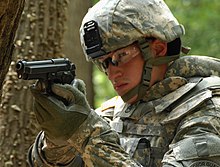Sidearm
The weapon that a soldier or a member of the police wields is called a sidearm . The term sidearm , however, in the modern police service named service weapon vanished.
History (Germany)
Until the 20th century were sidearms, above all, slashing and stabbing weapons ; With the development of firearms , they were used by the state organs carrying weapons .
Until 1918
Until 1918 the German police mainly wielded sabers as a side weapon , later the police were equipped with pistols .
Until 1945
Until 1945, the carrying of the sidearm was compulsory for various officers on certain occasions in Germany. The lower ranks of the professional fire brigades carried bayonets , the higher ranks carried sabers. Similarly, there was for the higher post - and railway officials as well as officials in the diplomatic service stab sword . In addition, foresters wore the hunting catcher as a sidearm.
The " SS honor dagger " introduced in December 1933 was considered an honor weapon . It was awarded on November 9th of each year to all SS men with their final admission to the SS and was considered the official SS side arm for the dress uniform .
The Reichswehr , like the Prussian Army before , prescribed the bayonet or saber (officers and infantry) for the army and the dagger as a side arm for officers of the Navy , which had to be worn with the uniform . The Wehrmacht took over the regulations of the Reichswehr except for the infantry saber. Officers with a patent before 1919 were allowed to carry their swords or swords. In addition, the officer's dagger was introduced for all branches of the army, the aviator's sword and the general's sword for the air force . The diplomatic service wielded the dagger. In 1944 the pistol was prescribed as a side arm for soldiers.
After 1945
In the National People's Army , officers wielded the pistol, dagger and saber as side arms. In the Bundeswehr officers only use the pistol as a side weapon.
Secondary weapon
The soldier's secondary armament is also referred to as a sidearm . Mainly for this purpose pistols or smaller submachine guns are carried in a holster on the body (hip or thigh). The side arm is used for self-defense of the soldier. Combat pilots are equipped with a pistol so that they can defend themselves if necessary after exiting. The cockpit has no space for larger primary weapons.
Difference to the side gun
The term sidearm is no longer to be confused with the term sidearm ( bayonet ), although the origin and meaning of the weapon and the meaning of the word are the same or similar.
Web links
Individual evidence
- ↑ Hans-Peter Stein: Symbols and ceremonial in German armed forces - from the 18th to the 20th century . Mittler Verlag, Bonn 1984, ISBN 978-3-8132-0161-1 , p. 115 .

